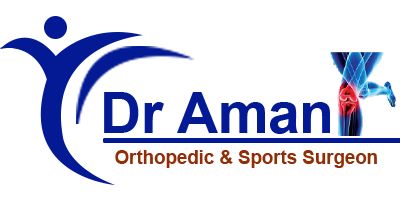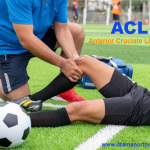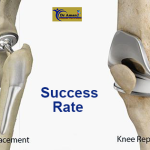ACL Tears: Causes, Symptoms, Treatment, & Recovery
Introduction
If you’re an athlete or someone who leads an active lifestyle, you’ve likely heard of ACL tears. ACL, short for the anterior cruciate ligament, is one of the most commonly injured knee ligaments. Whether you’re an athlete on the field or simply enjoy physical activities, understanding ACL tears is crucial. In this comprehensive guide, we’ll delve into the causes, symptoms, treatment options, and recovery process associated with ACL tears.
What is an ACL Tear?
An ACL tear is an injury to the anterior cruciate ligament, a critical component of your knee joint. The ACL connects your thigh bone (femur) to your shin bone (tibia) and plays a vital role in stabilizing the knee joint. When this ligament is damaged, it can result in severe pain, instability, and limited mobility.
Causes of ACL Tears
(1) Sports Injuries: ACL tears often occur during sports and physical activities that involve sudden stops, changes in direction, or direct contact with the knee. Common culprits include soccer, football, basketball, gymnastics, and lacrosse.
(2) Car Accidents: High-impact car ac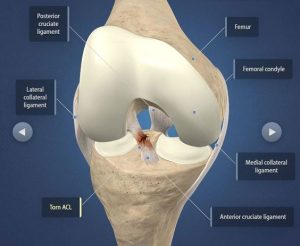 cidents can also lead to ACL tears, especially if the knee experiences a sudden jolt or twist during the collision.
cidents can also lead to ACL tears, especially if the knee experiences a sudden jolt or twist during the collision.
(3) Falls: A hard fall, particularly when landing awkwardly on the knee, can cause an ACL tear.
Symptoms of ACL Tears
Recognizing the symptoms of an ACL tear is essential for prompt diagnosis and treatment. Here are some common signs:
Audible “Pop”: Many individuals report hearing or feeling a popping sensation at the time of injury.
Swelling: The knee typically swells rapidly after an ACL tear.
Pain and Tenderness: Severe pain, soreness, and tenderness along the knee joint are common.
Decreased Range of Motion: You may notice a decreased ability to move your knee.
Instability: The knee may feel unstable, making it difficult to walk or bear weight.
Diagnosing ACL Tears
If you experience these symptoms, it’s crucial to seek medical attention. A healthcare provider can diagnose an ACL tear through a combination of physical examination and imaging tests, such as X-rays, CT scans, or MRIs.
Treating ACL Tears
The treatment approach for ACL tears varies based on the severity of the injury and individual circumstances.
Here are the main options:
Non-Surgical Treatment
For minor ACL injuries, non-surgical treatment may be sufficient. This approach involves:
Rest: Avoid activities that stress the knee.
Ice: Apply cold compresses to reduce swelling.
Compression: Use an elastic bandage to support the knee.
Elevation: Elevate the knee to reduce swelling.
Physical therapy is often recommended to regain strength and mobility gradually.
ACL Reconstruction Surgery
In cases where the ACL is severely torn or the knee is highly unstable, ACL reconstruction surgery is usually recommended. During this procedure:
The damaged ligament is removed.
A graft (replacement tissue) is inserted to create a new ACL.
The graft can be sourced from your patellar, hamstring, quadriceps, or cadaver tendons.
Minimally invasive arthroscopic techniques are commonly used for the surgery.
Recovery time after surgery varies, but it typically involves physical therapy to restore full range of motion, strength, and stability.
ACL Tear Prevention
While some ACL tears are unavoidable, there are steps you can take to reduce the risk:
Wear appropriate protective gear in sports.
Don’t push through knee pain during physical activities.
Allow your body adequate rest and recovery time.
Prioritize stretching and warm-up exercises.
Strengthen your knee joints during the offseason.
Living With an ACL Tear
Living with an ACL tear can be challenging, but with proper care and treatment, most individuals can regain function and return to their favorite activities. It’s essential to follow your healthcare provider’s advice and avoid rushing back into sports or intense physical activity.
Frequently Asked Questions
Q1: Can an ACL tear heal on its own?
A torn ACL cannot heal on its own. Surgery is often required for athletes and those seeking to return to physical activity.
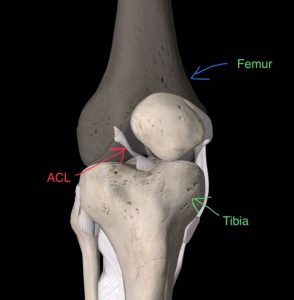
Q2: How long does it take to recover from a torn ACL?
Recovery usually takes six to nine months, but competitive athletes may need more time before returning to sports.
Q3: Is an ACL tear “career-ending” for an athlete?
Most ACL tears are not career-ending. Rehabilitation and proper care can often lead to a return to sports.
Conclusion
In conclusion, understanding ACL tears is crucial for athletes and active individuals. Recognizing the causes, symptoms, treatment options, and preventive measures can help you make informed decisions about your knee health. Whether you’re recovering from an ACL tear or looking to prevent one, remember that proper care and patience are key to a successful outcome.Best Orthopedic and Sports surgeon in Pakistan, Now Book your Appointment with Dr Aman orthopedic and Sports surgeon
